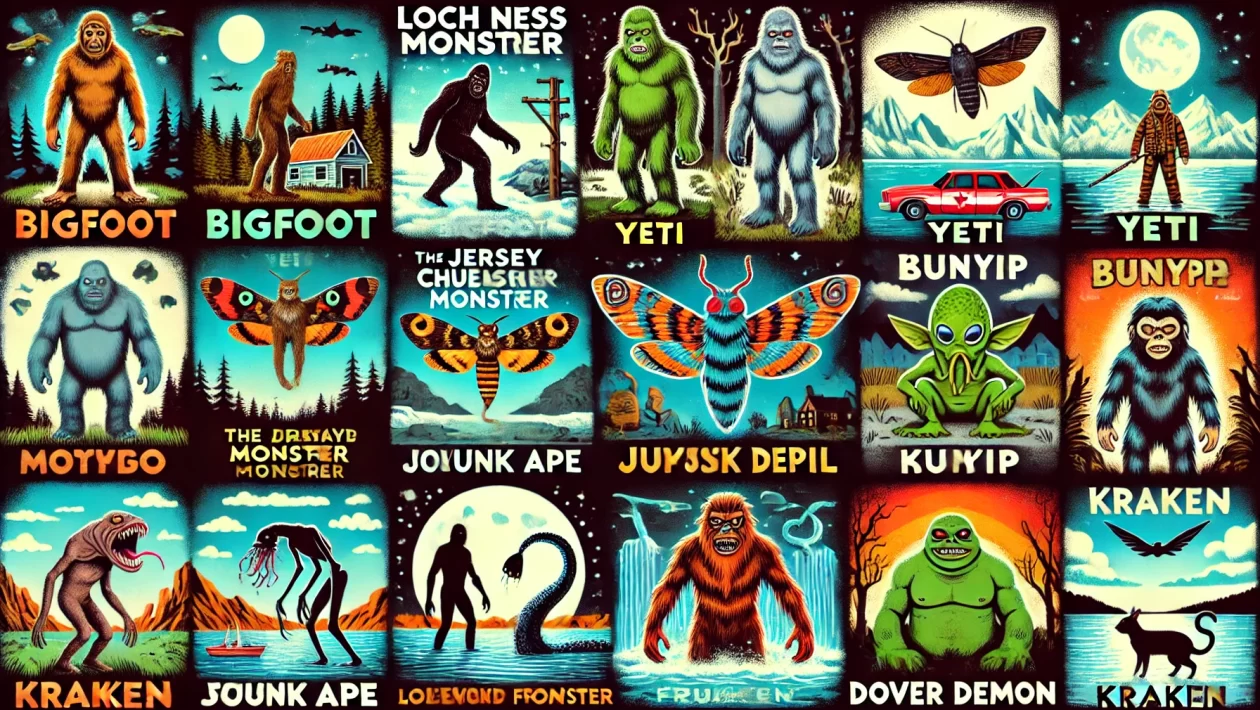Top 20 Cryptids and Their Habitat
Cryptids are creatures from folklore and myth that some people believe might exist despite a lack of scientific evidence. These enigmatic beings often inhabit the fringes of our imagination, driven by tales of sightings and cultural legends. Here, we explore 20 of the most intriguing cryptids, their histories, and the places you might encounter them.
1. Bigfoot (Sasquatch)
- Description: A large, hairy bipedal creature.
- History: Native American folklore includes tales of Sasquatch. The most famous modern sighting is the Patterson-Gimlin film from 1967.
- Habitat: North American forests, especially the Pacific Northwest.
- Evidence: Numerous sightings, footprint casts, and the Patterson-Gimlin film.
2. Loch Ness Monster (Nessie)
- Description: A large aquatic creature, often described as having a long neck.
- History: Reports date back to the 6th century. Modern interest surged after a 1933 sighting.
- Habitat: Loch Ness, Scotland.
- Evidence: Photographs, sonar readings, and eyewitness accounts.
3. Chupacabra
- Description: A creature said to drink the blood of livestock, typically described as reptilian or canine.
- History: First reported in Puerto Rico in the 1990s.
- Habitat: Latin America, the southern United States.
- Evidence: Livestock deaths with unusual bite marks, eyewitness reports.
4. Mothman
- Description: A humanoid with large wings and glowing red eyes.
- History: Sightings peaked in Point Pleasant, West Virginia, in the 1960s.
- Habitat: North America, primarily West Virginia.
- Evidence: Eyewitness accounts, media reports, and the collapse of the Silver Bridge.
5. Yeti (Abominable Snowman)
- Description: A large, ape-like creature covered in white fur.
- History: Integral to Himalayan folklore. Western attention grew after 19th-century expeditions.
- Habitat: Himalayan mountains.
- Evidence: Footprints, anecdotal reports, and alleged Yeti scalp and hand relics.
6. Jersey Devil
- Description: A winged creature with a goat’s head, bat wings, and cloven hooves.
- History: Originated in New Jersey folklore in the 18th century.
- Habitat: Pine Barrens, New Jersey.
- Evidence: Sightings, footprints, and strange noises.
7. Kraken
- Description: A giant sea monster resembling a squid or octopus.
- History: Scandinavian folklore, first described in the 13th century.
- Habitat: North Atlantic Ocean.
- Evidence: Historical sailors’ tales, possible giant squid sightings.
8. Bunyip
- Description: A water-dwelling creature described variously as having a dog-like face, flippers, and tusks.
- History: Aboriginal Australian folklore.
- Habitat: Swamps, billabongs, and creeks of Australia.
- Evidence: Mythical accounts, unverified sightings.
9. Thunderbird
- Description: A giant bird capable of creating thunder with its wings.
- History: Native American legends.
- Habitat: North America.
- Evidence: Anecdotal reports and large bird sightings.
10. Skunk Ape
- Description: A Bigfoot-like creature with a foul odor.
- History: Reported in Florida and the southeastern U.S. since the 1960s.
- Habitat: Florida Everglades.
- Evidence: Eyewitness accounts, blurry photographs, and footprints.
11. Mokele-Mbembe
- Description: A dinosaur-like creature resembling a sauropod.
- History: African folklore, particularly among the Congo River basin tribes.
- Habitat: Central Africa.
- Evidence: Indigenous reports, unverified expeditions.
12. El Chupacabra
- Description: A creature said to attack livestock and drain their blood.
- History: First reported in Puerto Rico in the 1990s.
- Habitat: Latin America and southern United States.
- Evidence: Eyewitness accounts, livestock carcasses.
13. Ogopogo
- Description: A serpentine lake monster.
- History: Native to Canadian folklore, especially in the Okanagan Valley.
- Habitat: Okanagan Lake, British Columbia, Canada.
- Evidence: Sightings, videos, and photographs.
14. The Flatwoods Monster
- Description: A tall, humanoid figure with a spade-shaped head.
- History: Sighted in Flatwoods, West Virginia, in 1952.
- Habitat: West Virginia.
- Evidence: Eyewitness accounts.
15. Batsquatch
- Description: A flying cryptid resembling a bat or a primate.
- History: First sighted near Mount St. Helens after its eruption in 1980.
- Habitat: Pacific Northwest.
- Evidence: Eyewitness reports.
16. Fouke Monster (Boggy Creek Monster)
- Description: A Bigfoot-like creature reportedly sighted near Fouke, Arkansas.
- History: Sightings began in the early 20th century.
- Habitat: Boggy Creek area, Arkansas.
- Evidence: Eyewitness accounts, footprints, local legends.
17. Wendigo
- Description: A cannibalistic spirit or monster from Algonquian folklore.
- History: Native American legends describe it as a malevolent, supernatural being.
- Habitat: Northern forests of the U.S. and Canada.
- Evidence: Cultural stories, anecdotal reports.
18. Mapinguari
- Description: A large, bipedal creature with long claws and a sloth-like appearance.
- History: Brazilian and Amazonian folklore.
- Habitat: Amazon rainforest.
- Evidence: Indigenous reports, unverified sightings.
19. Loveland Frogman
- Description: A humanoid frog reported in Loveland, Ohio.
- History: First sighted in 1955.
- Habitat: Loveland, Ohio.
- Evidence: Police officer reports, anecdotal sightings.
20. Dover Demon
- Description: A small, humanoid creature with large eyes and a thin body.
- History: Sighted in Dover, Massachusetts, in 1977.
- Habitat: Massachusetts.
- Evidence: Eyewitness accounts, drawings by witnesses.
Conclusion
Cryptids continue to fascinate us, blending folklore, mythology, and the possibility of undiscovered creatures. While scientific evidence remains scarce, the persistent reports and cultural significance of these beings ensure they remain a captivating topic for both believers and skeptics alike.
For more detailed information on each cryptid and the latest sightings, you can visit reputable cryptozoology sites and forums such as Squatchable.com and the Bigfoot Field Researchers Organization (BFRO).
